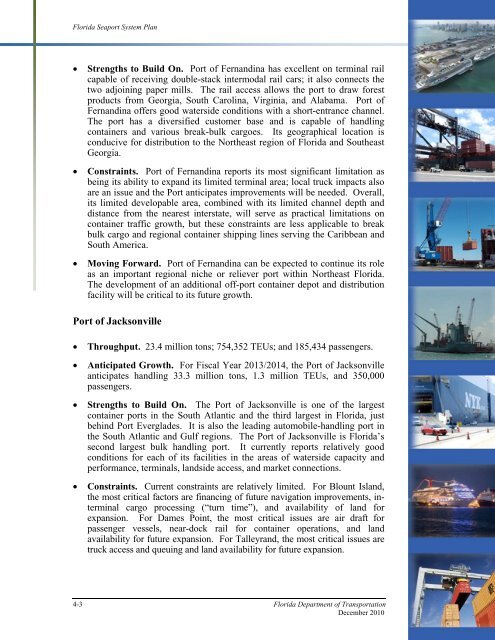Florida Seaport System Plan - SeaCIP
Florida Seaport System Plan - SeaCIP
Florida Seaport System Plan - SeaCIP
Create successful ePaper yourself
Turn your PDF publications into a flip-book with our unique Google optimized e-Paper software.
<strong>Florida</strong> <strong>Seaport</strong> <strong>System</strong> <strong>Plan</strong><br />
• Strengths to Build On. Port of Fernandina has excellent on terminal rail<br />
capable of receiving double-stack intermodal rail cars; it also connects the<br />
two adjoining paper mills. The rail access allows the port to draw forest<br />
products from Georgia, South Carolina, Virginia, and Alabama. Port of<br />
Fernandina offers good waterside conditions with a short-entrance channel.<br />
The port has a diversified customer base and is capable of handling<br />
containers and various break-bulk cargoes. Its geographical location is<br />
conducive for distribution to the Northeast region of <strong>Florida</strong> and Southeast<br />
Georgia.<br />
• Constraints. Port of Fernandina reports its most significant limitation as<br />
being its ability to expand its limited terminal area; local truck impacts also<br />
are an issue and the Port anticipates improvements will be needed. Overall,<br />
its limited developable area, combined with its limited channel depth and<br />
distance from the nearest interstate, will serve as practical limitations on<br />
container traffic growth, but these constraints are less applicable to break<br />
bulk cargo and regional container shipping lines serving the Caribbean and<br />
South America.<br />
• Moving Forward. Port of Fernandina can be expected to continue its role<br />
as an important regional niche or reliever port within Northeast <strong>Florida</strong>.<br />
The development of an additional off-port container depot and distribution<br />
facility will be critical to its future growth.<br />
Port of Jacksonville<br />
• Throughput. 23.4 million tons; 754,352 TEUs; and 185,434 passengers.<br />
• Anticipated Growth. For Fiscal Year 2013/2014, the Port of Jacksonville<br />
anticipates handling 33.3 million tons, 1.3 million TEUs, and 350,000<br />
passengers.<br />
• Strengths to Build On. The Port of Jacksonville is one of the largest<br />
container ports in the South Atlantic and the third largest in <strong>Florida</strong>, just<br />
behind Port Everglades. It is also the leading automobile-handling port in<br />
the South Atlantic and Gulf regions. The Port of Jacksonville is <strong>Florida</strong>’s<br />
second largest bulk handling port. It currently reports relatively good<br />
conditions for each of its facilities in the areas of waterside capacity and<br />
performance, terminals, landside access, and market connections.<br />
• Constraints. Current constraints are relatively limited. For Blount Island,<br />
the most critical factors are financing of future navigation improvements, interminal<br />
cargo processing (“turn time”), and availability of land for<br />
expansion. For Dames Point, the most critical issues are air draft for<br />
passenger vessels, near-dock rail for container operations, and land<br />
availability for future expansion. For Talleyrand, the most critical issues are<br />
truck access and queuing and land availability for future expansion.<br />
4-3 <strong>Florida</strong> Department of Transportation<br />
December 2010
















